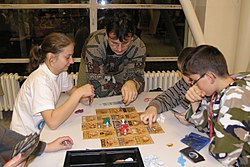Blue Moon City
| Blue Moon City | |
|---|---|

|
|
| Game data | |
| author | Pure Knizia |
| publishing company |
Cosmos , Fantasy Flight Games , Brain Games , Galakta |
| Publishing year | 2006 |
| Art | Board and card game |
| Teammates | 2 to 4 |
| Duration | 60 minutes |
| Age | from 10 years on
|
| Awards | |
|
German Games Award 2006: 4th place |
|
Blue Moon City is a board and card game by Reiner Knizia that was published in 2006 by Spieleverlag Kosmos . It is suitable for 2-4 players, ages 10 and up, and takes about 60 minutes. The game was on the nomination list for the Critics' Prize Game of the Year 2006 and reached number 4 at the German Game Prize .
Blue Moon City is set in the world of the card game Blue Moon by the same author from 2004. In the meantime, a book by Frank Rehfeld has also been published which takes up characters and motifs from the game world.
Theme and equipment
The fantastic city of Blue Moon City was destroyed in a conflict and must now be rebuilt through the cooperation of all races in the world. Each building requires a different effort, which is applied by cards with colored markings.
The buildings are represented by 21 square cards drawn by the illustrator Franz Vohwinkel with construction plans on one side and the completed building on the reverse. They are arranged around a central obelisk .
Game flow
The player in turn moves his token a maximum of two buildings. With cards in hand he can help build the structure he is standing on. How many individual construction phases it needs, at what price and in what color is marked on each building. When all the necessary construction phases have been carried out on the structure, the card is turned over and now shows the completed building. The players involved in the construction receive the amount of crystal splinters, dragon scales and, in some cases, additional cards indicated on the card as a reward. The builder of the last post receives a bonus and other rewards if neighboring buildings have already been completed.
The contributions to the construction of a structure consist of cards from the hand of the player, which must reach the appropriate color and added up the value of the contribution. Some cards also have a special function that can be used instead of the nominal value. Color values can be exchanged, numerical values can be increased or colored dragon figures can be introduced to help with construction.
The dragon scales can be exchanged for crystal splinters, which can be offered as "sacrifices" at increasing prices during the game. The large crystal of the central obelisk is assembled from these sacrifices, the completion of which marks the end of the game. Whoever made the most sacrifices wins.
Extensions
In 2006, two small expansions, each with two new building cards, appeared. They are not available in stores, but only as additions to a publication by the game author or a game magazine.
Target group and gameplay
The game is aimed on the one hand at fans of the two-person card game who want to play in a larger group, but on the other hand it is completely independent. The theme and presentation appeal to fans of fantastic worlds, the game principle is conventional and the special functions of the cards allow varied moves.
No player can work for himself because he never gets all the necessary cards in hand. The buildings can only be completed through cooperation. The graduated remuneration also rewards cooperation.
Web links
- Blue Moon City in the Luding games database
- Blue Moon City in the game database BoardGameGeek (English)
- Full review at H @ ll 9000.
- Review by Holgs Spieleteufel